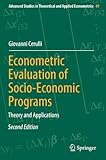Econometric evaluation of socio-economic programs: theory and application
Material type: TextSeries: Advanced Studies in Theoretical and Applied Econometrics; vol. 49Publication details: Cham Springer 2023Edition: 2ndDescription: xviii, 340 pISBN:
TextSeries: Advanced Studies in Theoretical and Applied Econometrics; vol. 49Publication details: Cham Springer 2023Edition: 2ndDescription: xviii, 340 pISBN: - 9783662659472
- 330.015195 CER
| Item type | Current library | Collection | Call number | Status | Date due | Barcode | |
|---|---|---|---|---|---|---|---|
 Book
Book
|
Indian Institute of Management LRC General Stacks | Public Policy & General Management | 330.015195 CER (Browse shelf(Opens below)) | Available | 008991 |
Table of contents:
Front Matter
Pages i-xviii
Download chapter PDF
An Introduction to the Econometrics of Program Evaluation
Giovanni Cerulli
Pages 1-46
Methods Based on Selection on Observables
Giovanni Cerulli
Pages 47-152
Methods Based on Selection on Unobservables
Giovanni Cerulli
Pages 153-216
Local Average Treatment Effect and Regression-Discontinuity-Design
Giovanni Cerulli
Pages 217-299
Difference-in-Differences with Many Pre- and Post-Treatment Times
Giovanni Cerulli
Pages 301-322
Synthetic Control Method
Giovanni Cerulli
Pages 323-340
[https://link.springer.com/book/10.1007/978-3-662-65945-8]
This book provides advanced theoretical and applied tools for the implementation of modern micro-econometric techniques in evidence-based program evaluation for the social sciences. The author presents a comprehensive toolbox for designing rigorous and effective ex-post program evaluation using the statistical software package Stata. For each method, a statistical presentation is developed, followed by a practical estimation of the treatment effects. By using both real and simulated data, readers will become familiar with evaluation techniques, such as regression-adjustment, matching, difference-in-differences, instrumental-variables, regression-discontinuity-design, and synthetic control method, and are given practical guidelines for selecting and applying suitable methods for specific policy contexts.
The second revised and extended edition features two new chapters on some recent development of difference-in-differences. Specifically, chapter 5 introduces advanceddifference-in-differences methods when many times are available and treatment can be either time-varying or fixed at a specific time. Chapter 6 introduces the synthetic control method, a treatment effect estimation approach suitable when only one unit is treated. Both chapters present applications using the software Stata.
(https://link.springer.com/book/10.1007/978-3-662-65945-8)
There are no comments on this title.

